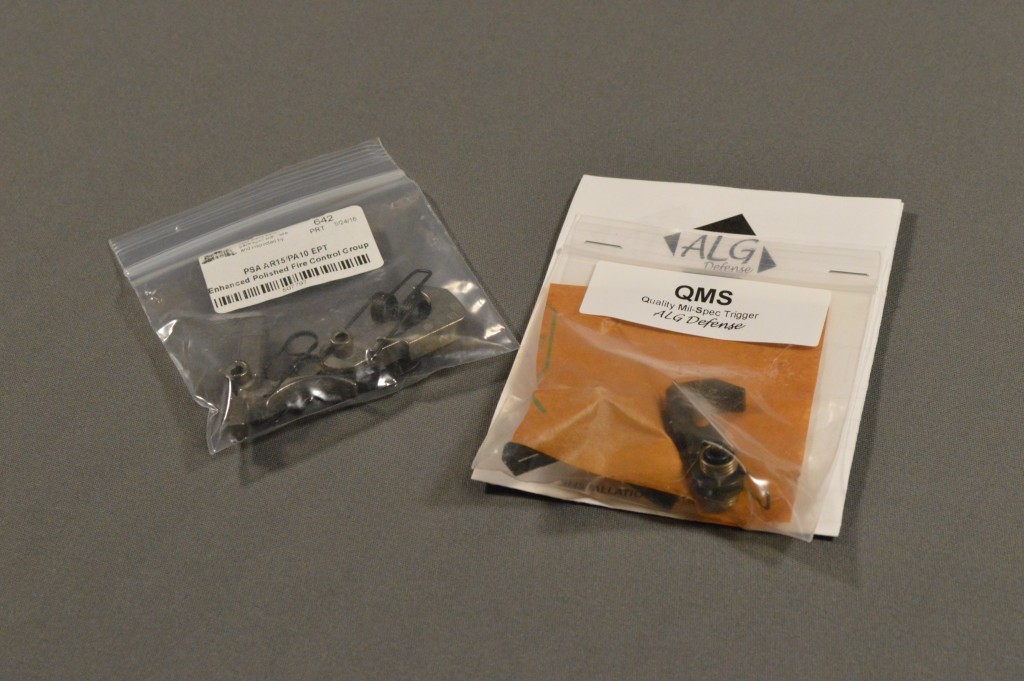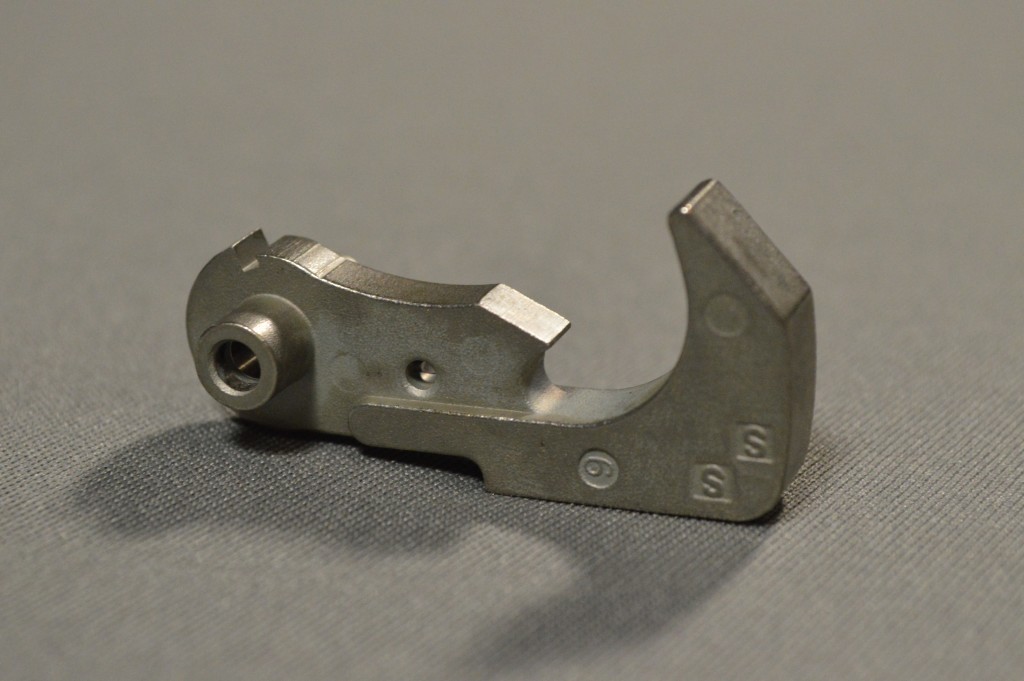Triggered: ALG Defense QMS vs. Palmetto State Armory EPT
In the eight or nine years I’ve been shooting AR-15s, I’ve changed upper receiver assemblies four times, swapped stocks three times, exchanged pistol grips twice, added a railed handguard once, and experimented with more optics than I can count. Despite all these changes, the one part inside all of my rifles that I’ve never upgraded is the trigger. For some reason, I’ve always struggled to justify the cost of new triggers when my current ones work perfectly well.
The problem with my old philosophy is that a rifle’s trigger can impact performance in a way that few other parts can. While I was busy making mostly aesthetic changes to my ARs, I neglected parts that could truly make me a better shooter (or at least a more successful one). Even with this realization in mind, I still didn’t want to drop coin on $100+ triggers without first sampling some of the wallet-friendly options that are currently available. With a budget of $50 per trigger, I set out to find two new assemblies to add to my ARs. At this price, most options are mostly cleaned up versions of the standard milspec trigger. After scouring the Memorial Day sales, I settled on the Enhanced Polished Trigger (EPT) from Palmetto State Armory and the Quality Mil-Spec Trigger (QMS) from ALG Defense.
Test Platforms
If we’re going to compare two different triggers like we are here today, it is critical that we keep our test platforms as consistent as possible. Rather than try to swap the units in and out of the same rifle, I selected my two closely numbered Del-Ton receivers as reasonably good test bases. Both receivers were purchased at the same time and feature serial numbers just two digits apart from one another.
To further help validate my controlled variables, I measured and averaged the pull weights of the Del-Ton triggers that have resided in the two rifles since they were assembled. In a 20-pull test, the trigger in my M16A4 clone (Del-Ton 1 for our purposes) averaged 6.7 lbs and the one in my SR-15 build (Del-Ton 2) hovered around 6.3 lbs on average. Because there was a measurable difference between the two trigger groups, I flipped them and verified that Del-Ton 1 remained heavier than Del-Ton 2. Since Del-Ton 2 has seen considerably more use than Del-Ton 1, I am comfortable concluding that the two receivers are consistent enough for this comparison.
Take-Up
One of my few gripes with the Del-Ton trigger assemblies is the amount of take-up they feature. Though the take-up on each unit is well within the range of what most would expect from a milspec AR trigger, the 1-1.5mm of slack before the break is sometimes enough to invoke a flier. Otherwise, Del-Ton’s parts are actually quite good.
The EPT also features a small amount of take-up, but it feels very different than that of the Del-Ton assemblies. Rather than the gritty or lumpy feel of the Del-Tons, the EPT has around 1mm of springy, smooth take-up before the break. For me, the EPT’s pull “feels” better than the Del-Ton triggers.
While the EPT performs admirably, ALG’s QMS wins this category hands down. The QMS has effectively zero take-up. Once you place your finger on the trigger, you are already at the wall before the break. Truly, for a milspec trigger, the QMS is a remarkable performer in this regard.
Reset
Though Del-Ton’s triggers are very nice for standard parts, their resets leave something to be desired. On both examples, the same (or worse) grittiness that was present in the take-up also made an appearance during reset. At the range, I’ve found graininess especially annoying as I often “ride the reset” between shots.
The EPT’s reset offers a much different feel than the Del-Ton examples and the QMS. Much like its take-up, the reset with the PSA trigger has a sort of smooth, springy feel. It also happens to be around 30% shorter than the Del-Ton, but we’re talking about some really miniscule distances here. Of the bunch, the EPT’s reset is my favorite, even if it isn’t quite as short as the QMS’s.
Part of the reason I prefer the EPT’s reset over that of the QMS is that the ALG product requires that I take almost all pressure off the trigger before it snaps forward. Sure, the travel distance is incredibly short, but having to lift my finger mostly off the trigger for it to reset is somewhat annoying. As with the EPT, the QMS makes a very audible “click” once it returns to the forward, firing position. Fundamentally speaking, the QMS with its nonexistent take-up and negligible reset distance is probably the “better” trigger, but personal preferences pull me to the EPT in this category.
Pull Weight & Break
I was pleasantly surprised to find that the EPT noticeably reduced the weight of my rifle’s trigger pull. In comparison to Del-Ton 2’s 6.3 lb average, the EPT came in a bit lower at 6.2 lbs. This isn’t a huge improvement, but combined with the enhanced take-up, makes for a much better trigger. If you’ve ever fired a factory Glock, the EPT feels somewhat similar to the last bit of pull, just before the break (ignoring the Glock’s initial take-up).
On the flip side, ALG’s QMS actually added a small amount of weight to my M16A4 clone’s pull. While Del-Ton 1 offered pull weight in the 6.7 lb neighborhood, the QMS sits at 6.8 lbs. Once again, it isn’t a massive change and I wouldn’t let these measured weights sway me away from the QMS.
To build a more comprehensive comparison, I also swapped the QMS into my SR-15 build and tested the trigger using my Lyman digital gauge. In the KAC-topped rifle, the QMS served up 20-shot average pull weight of 6.6 lbs. Once again, the QMS came in heavier than the EPT, but exchanging lower receivers seemed to benefit the ALG group.
The real improvement offered by both the EPT and QMS comes in terms of consistency. The Del-Ton triggers are perfectly good, basic parts that have served me well for six years, but they aren’t as consistent as the challengers from ALG and PSA. In terms of pull weight, Del-Ton 1 and 2 offer standard deviations of 0.52 and 0.46 lbs respectively. Meanwhile, the EPT’s standard deviation sits at 0.25 lbs and the QMS’s at a fantastic 0.24 lbs. Depending on the comparison, the stock triggers are between 80% and 100% less consistent than the enhanced parts.
Conclusion
Before I try to pick a winner, I think it is important to consider whether or not swapping functional standard triggers for ones like the EPT and QMS makes sense. As we have seen, the upgraded parts offer little-to-no reduction in pull weight (nor are they intended to) and the enhancements in other areas are noticeable, but rather minor. With these things in mind, I’m not sure I would purchase one of these as a replacement for a decent (sub-7 lb pull weight) factory assembly.
Still, I do prefer PSA’s EPT over the QMS from ALG. The QMS is exceptionally well built and delivers the shortest take-up/reset I’ve ever felt in an AR-15. However, it is also slightly heavier than the Del-Ton unit it replaced and the feel of the short reset makes it difficult to ride the trigger between shots.


On the winning side, the EPT lightened my AR’s trigger to around six pounds. It also offers improved take-up and reset when compared to the factory Del-Ton triggers. Finally, PSA frequently sells the EPT for as low as $30 while the QMS typically goes for between $45 and $50, depending on current sales and individual retailer pricing. With pricing in mind, I simply don’t feel that the QMS is worth the ~50% premium.
An information security professional by day and gun blogger by night, Nathan started his firearms journey at 16 years old as a collector of C&R rifles. These days, you’re likely to find him shooting something a bit more modern – and usually equipped with a suppressor – but his passion for firearms with military heritage has never waned. Over the last five years, Nathan has written about a variety of firearms topics, including Second Amendment politics and gun and gear reviews. When he isn’t shooting or writing, Nathan nerds out over computers, 3D printing, and Star Wars.








